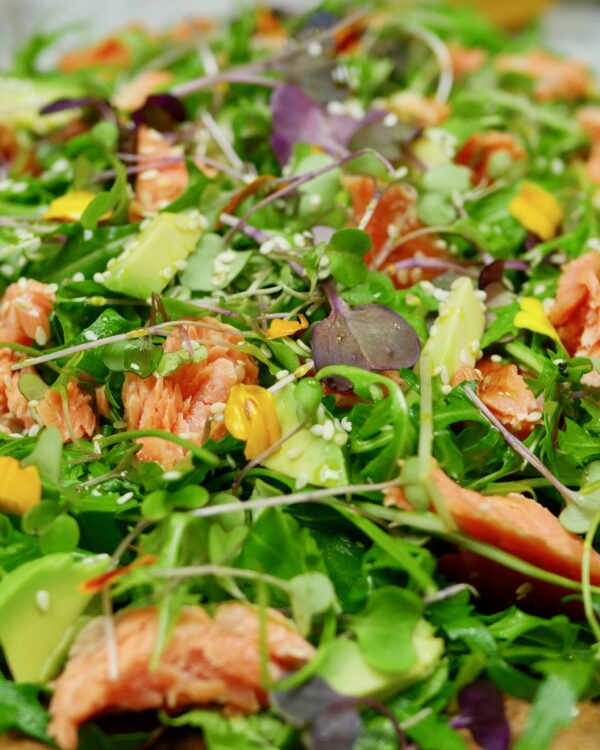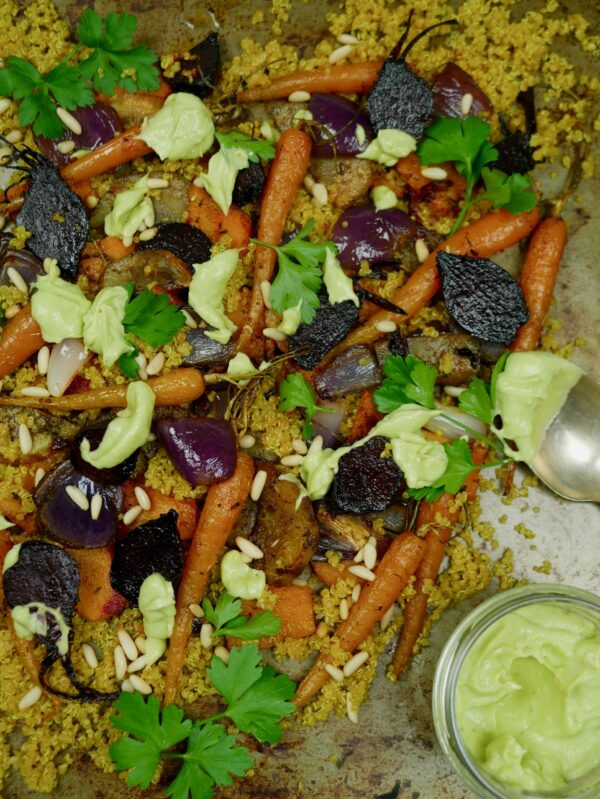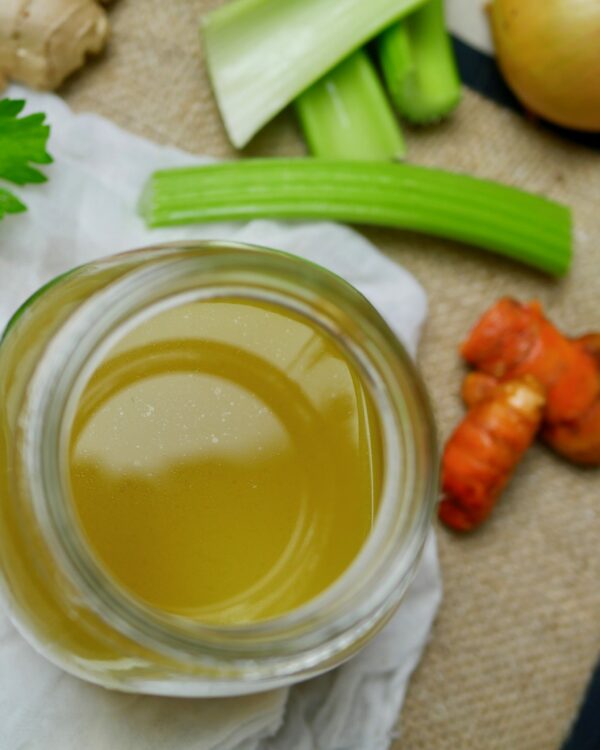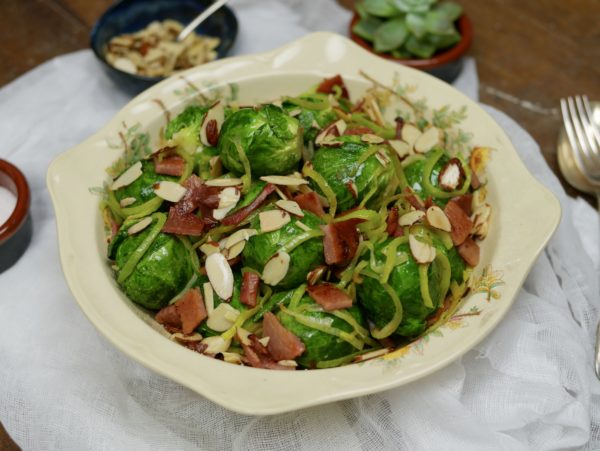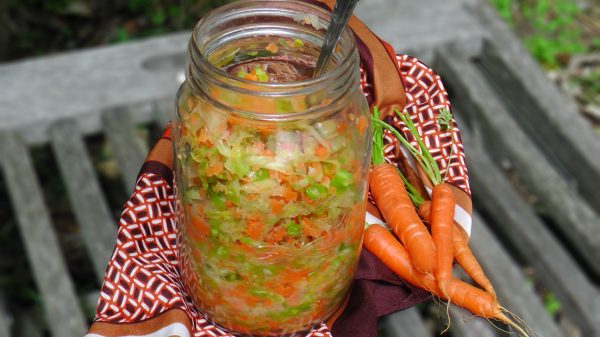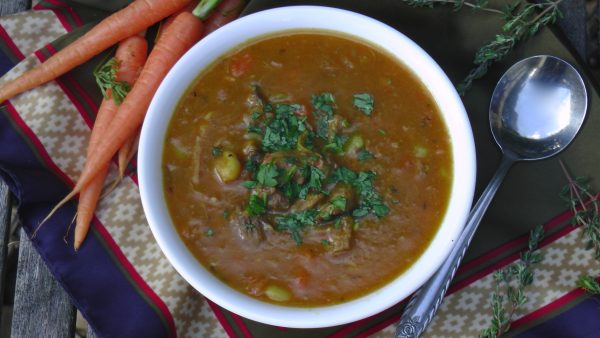Warm Earth Salad with Creamy Avocado Dressing
Preparation: 20 minutes Cooking: 25 minutes Servings: 4 as a side This is a lovely and satisfying warm earthy salad that is perfect on its own or accompanying a piece of fish or chicken. Roasted earth vegetables are tossed with warm, fluffy turmeric and lemon quinoa, dressed with a vibrant, creamy avocado dressing. Brain Food Note Pumpkin and sweet potato work well here to improve memory and concentration, while the protein, magnesium, and folate in quinoa stabilises mood and reduces anxiety. Golden turmeric helps calm and clear the mind, and the zing of lemon hinders anxiety. Vibrant red beets help with mental fatigue and alertness, plus I’ve added smooth avocado for good healthy fats to boost brainpower. You Will Need 6 baby beets, peeled and halved 10 baby carrots, peeled and whole 3 small red onions, peeled and quartered 1 cup pumpkin, peeled and cubed 1 cup sweet potato, peeled and cubed 4 garlic cloves, halved 2 tablespoons coconut oil or ghee 1 teaspoon sweet paprika 1 cup white uncooked quinoa 2 cups chicken or vegetable broth 1 teaspoon turmeric powder 1/2 teaspoon ground cumin zest and juice of 1 lemon 1 handful flat-leaf parsley, torn 2 tablespoons pine nuts, toasted Dressing 1/2 avocado 3 tablespoons coconut milk 1 garlic clove, roasted 1/2 cup flat-leaf parsley 1/4 teaspoon salt 1/2 cup olive oil What to Do Preheat the oven to 180 degrees C. Wash and prepare the vegetables. Place the beets, carrots, onions, pumpkin, sweet potato, salad garlic, and dressing garlic with coconut oil or ghee in a large roasting dish. Sprinkle the paprika over the top. Cook the vegetables for 20–25 minutes, or until they are just tender. Strain the quinoa through a fine mesh sieve, rinsing through with clean cool water for 2 minutes. Place the quinoa in a small saucepan and add 2 cups of broth. Bring to a boil, then turn down the heat and simmer for 20 minutes, uncovered. Stir in the turmeric powder, cumin, and lemon zest and squeeze over the lemon juice. Fluff the quinoa with a fork. Remove a clove of roasted garlic from the oven and place it, plus all of the other dressing ingredients except olive oil, in a blender. Process until well combined. With the blender on low, slowly pour in the oil and blend until the dressing thickens. Transfer to a small bowl. Any leftover dressing will keep stored in a sealed glass jar in the refrigerator for 3–5 days. Place the quinoa and roasted vegetables in a large bowl and toss gently to combine. Pile the warm vegetable salad onto a platter and toss the parsley and a sprinkle of pine nuts over the top. Spoon the dressing into a small bowl and place it on the side. Dress the salad before serving or leave for guests to dress the amount they desire.Kale and Quinoa Salad
Preparation: 15 minutes Cooking: 30 minutes Servings: 4 This emerald-green kale salad pairs the slight chewiness of kale with the lovely bite of quinoa. The vibrant salad is sensational on its own or paired with your favourite protein. Adorn the kale with creamy cashew or feta cheese and a sprinkle of crunchy toasted pumpkin seeds. Brain Food Note Dark leafy greens are good sources of folate and vitamins C, A, and E, which are important for overall cognition, emotional stability, and happiness. Combine with quinoa, a powerhouse of protein, magnesium, iron, zinc, and omega-3s to help stabilise mood and ease anxiety-induced depression, and broccoli, which is high in folate to calm a busy brain. Top with the magnesium-rich cashew cheese and toasted pumpkin seeds, which work together beautifully to help ease anxiety and low mood.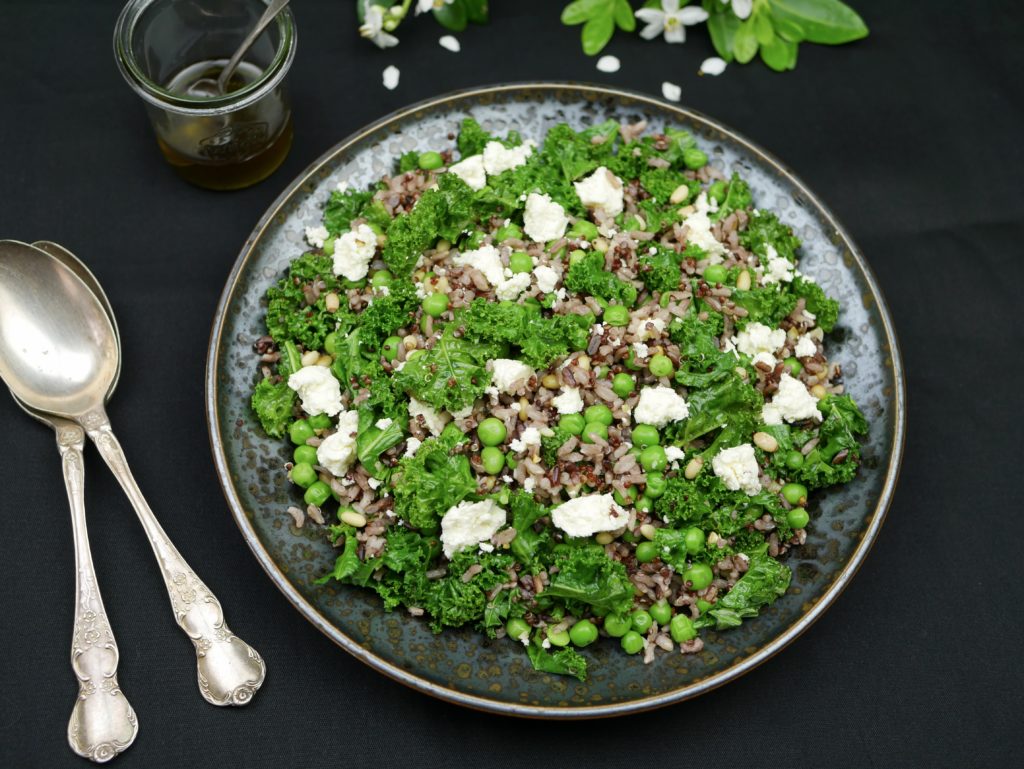 1 cup uncooked quinoa (I've used a quinoa/rice mix in this recipe)
2 cups chicken/vegetable broth
1 cup kale, stalks removed
2 tablespoons coconut oil
1 cup frozen or fresh peas or 1/2 broccoli head (I've used peas in this recipe, but I also use broccoli)
2 cloves garlic
6 tablespoons olive oil
juice of 1 lemon
1/2 cup of feta or 1/2 cup cashew cheese
2 tablespoons pumpkin seeds, toasted
Place 1 cup of quinoa or a quinoa rice blend in a fine mesh sieve and rinse with cool, clean running water for 2 minutes.
Transfer the quinoa to a small saucepan and add 2 cups of broth. Bring to a boil, then turn down the heat and simmer for 15–20 minutes uncovered, until the liquid is almost all absorbed. Add the peas or broccoli florets and simmer for a further 5 minutes, until the liquid is completely absorbed. In the meantime, break the kale leaves into small pieces.
Remove the quinoa pot from the heat and let it stand for 5 more minutes, covered. Remove the lid and fluff the quinoa with a fork. Set aside to cool.
Heat the coconut oil in a large frying pan over high heat. Fry the garlic for 1–2 minutes, or until soft and fragrant. Add the kale pieces and cook until softened (around 5 minutes).
In a large bowl, combine the cooled quinoa, kale, and peas or broccoli. In a small jar, combine olive oil, lemon juice, sea salt, and freshly ground black pepper. Shake the jar well to combine the dressing ingredients.
Drizzle as much dressing as you prefer over the salad and toss gently. Place the tossed salad on a large plate or platter. Crumble the feta or spoon cashew cheese over the top. Sprinkle with toasted pumpkin seeds.
1 cup uncooked quinoa (I've used a quinoa/rice mix in this recipe)
2 cups chicken/vegetable broth
1 cup kale, stalks removed
2 tablespoons coconut oil
1 cup frozen or fresh peas or 1/2 broccoli head (I've used peas in this recipe, but I also use broccoli)
2 cloves garlic
6 tablespoons olive oil
juice of 1 lemon
1/2 cup of feta or 1/2 cup cashew cheese
2 tablespoons pumpkin seeds, toasted
Place 1 cup of quinoa or a quinoa rice blend in a fine mesh sieve and rinse with cool, clean running water for 2 minutes.
Transfer the quinoa to a small saucepan and add 2 cups of broth. Bring to a boil, then turn down the heat and simmer for 15–20 minutes uncovered, until the liquid is almost all absorbed. Add the peas or broccoli florets and simmer for a further 5 minutes, until the liquid is completely absorbed. In the meantime, break the kale leaves into small pieces.
Remove the quinoa pot from the heat and let it stand for 5 more minutes, covered. Remove the lid and fluff the quinoa with a fork. Set aside to cool.
Heat the coconut oil in a large frying pan over high heat. Fry the garlic for 1–2 minutes, or until soft and fragrant. Add the kale pieces and cook until softened (around 5 minutes).
In a large bowl, combine the cooled quinoa, kale, and peas or broccoli. In a small jar, combine olive oil, lemon juice, sea salt, and freshly ground black pepper. Shake the jar well to combine the dressing ingredients.
Drizzle as much dressing as you prefer over the salad and toss gently. Place the tossed salad on a large plate or platter. Crumble the feta or spoon cashew cheese over the top. Sprinkle with toasted pumpkin seeds.
Chicken Bone Broth
Preparation: 10 minutes Cooking: 12 hours Servings: 2 litres I make bone broth every week, and we have it as a healing drink most days, or I use it for stock and warm, nurturing soups. I recommend that everyone make bone broth and incorporate it into the dietary routine. Make your own broth to get all the health benefits and use any vegetables you have on hand to make it your own. Making your own broth means you know exactly what goes in it rather than purchasing store-bought broth, which can have unnecessary, unhealthy ingredients. I love having a batch simmering away in the slow cooker all day or overnight. You can make broth anytime, but I like to make it just before bed; then it’s ready and hot for breakfast. If you don’t have a slow cooker, just use a large pot with a lid, but you won’t be able to make it overnight. Brain Food Note The gelatin in bone broth protects and heals the lining of the digestive tract, helps aid in the digestion of nutrients, and is rich in natural protein that supports the immune system and brain function. 1 organic chicken carcass (meat stripped) 2 litres of water 2 stalks of celery, roughly chopped 2 leaves of silver beet, torn 2 carrots, roughly chopped 1 onion, roughly chopped 3 cloves garlic, crushed 1 thumb-sized piece of fresh ginger 1 thumb-sized piece of fresh turmeric 1/2 teaspoon sea salt 1 teaspoon turmeric powder 1 tablespoon black peppercorns 1 tablespoon apple cider vinegar 5 thyme sprigs 1 handful fresh flat-leaf parsley Place all ingredients in a slow cooker and cook on high for one hour. Reduce to low heat for 10–11 hours. Remove from heat. Strain the stock through a sieve into a large bowl and leave to cool for 30 minutes before pouring into a jug or container. Cover and place in the refrigerator. When the broth cools, fat will rise to the top. Skim this off and reuse for cooking. The broth can be stored in the refrigerator for up to 1 week, or frozen for up to 2 months. You can swap out the chicken bones, for beef or fish and also use other parts like chicken feet and neck. Your butcher can cut large tubular bones in half so that you can get to the nutritious bone marrow and if you are making a fish stock, you can use the entire fish. It's the gelatinous soft tissues that surround the bones and the bone marrow that provide some of the best healing remedies for the gut lining and immune system.Brussels Sprout, Leek, and Bacon Salad
Preparation: 10 minutes Cooking: 15 minutes Servings: 4 as a side This lovely, simple salad packs a powerful nutrient-rich punch. Brussels sprouts bring a fresh clarity to the dish; their bright green colour and sweet, nutty flavour pair well with the subtle tones of the soft pale leek. Add the crisp saltiness of bacon and the necessary crunch of sliced almonds and you have a lovely salad, substantial enough for a light meal or perfect as a side with your favourite protein dish. Brain Food Note Brussels sprouts contain many nutrients, including vitamin C and B vitamins, to improve the mood (including reducing mood swings). I’ve added protein- and iron-rich bacon to further promote a balanced state, and almonds for zinc to help create a calm mind. 12 Brussels sprouts 1/2 leek 4 rashers of bacon 1/4 cup sliced almonds, toasted juice of 1/2 lemon (optional) freshly ground black pepper sea salt Preheat the oven to 180 degreesC. Wash the Brussels sprouts, slice off the ends, and remove the outer leaves. Wash the leek and slice it into thin strips. Place the rashers of bacon in a roasting pan and cook for 7–8 minutes, or until crispy and brown. Remove the bacon from the pan and add the Brussels sprouts to the bacon fat. Roast for 5 minutes. Remove from heat, add sliced leeks, and cook for an additional 2 minutes. Remove the pan from the oven and add the bacon (cut into small squares) back to the pan. Squeeze over lemon juice, if desired. Season with freshly ground black pepper and sea salt. Transfer to a serving dish and sprinkle the toasted sliced almonds over the top.Carrot and Turmeric Soup
Preparation: 15 minutes Cooking: 4 hours Serves: 4-5 This bright, vibrant soup is a bit of sunshine in a bowl. The delicate, sweetness of the carrots hardly need much to make their flavour sing. This is a simple soup of either purple or orange carrots cooked over a long slow heat with warm spices of ginger, cinnamon and turmeric and then blended to create a smooth silky soup. A swirl of coconut cream and a sprinklng of toasted pumpkin seeds would work beautifully here to maximise the brain health benefits. Brain Food Note Carrots containe carotenoids; plant pigments that give carrots their colour. Cartenoids have been linked to better mood, clearer mind and uplifted thoughts. Turmeric is known for its anti-inflammation properties and its main active ingredient curcumin helps balance brain chemicals. The healing gelatin in bone broth nourishs your gut and relaxes your mind. The curcumin is readily absorbed when partnered with black pepper and healthy fats like coconut cream. Top with some pumpkin seeds for a feel good hit of magnesium. 12 large orange or purple carrots, sliced 1 inch thick 1 small onion, chopped finely thumb sized piece turmeric root, chopped finely 2 garlic cloves, chopped finely thumb sized piece ginger, chopped finely 1 teaspoon of turmeric powder ½ teaspoon of cinnamon 4 cups chicken or vegetable bone broth ½ teaspoon of sea salt ½ teaspoon of freshly ground black pepper To Top 2 teaspoons thyme leaves, chopped 2 tablespoons pumpkin seeds, roasted swirl of coconut cream (optional) sea salt freshly ground black pepper Melt the coconut oil in a large saucepan over a medium heat. Add the onion, garlic and ginger and cook for 2 minutes or until soft and fragrant. Add turmeric root, cinnamon and turmeric powder. Cook for a further 2 minutes stirring occasionally. Transfer to your slow cooker and add carrots, bone broth and thyme. Cook on high for 3 ½ hours or until carrots are very tender. Ladle mixture into a high speed blender and blitz for 45 secs until smooth. Ladle soup into warmed bowls and garnish with thyme and toasted pumpkin seeds. Serve with fingers of toasted homemade bread.Cabbage and Carrot Sauerkraut
We all have a vast community of bacteria that live within us, called the microbiome. The microbiome in our gut controls many of our body’s key functions and is crucial to our overall health. A balanced microbiome regulates the immune system, modulates weight and metabolism, and provides us with critical vitamins. Your mental health, not only your physical health, is deeply influenced by the health of your gut too. A healthy microbiome supports mood and brain function. When your microbiome falls out of balance, you can become ill. Consuming naturally fermented foods is one of the best ways to balance the microbiome in your gut. Fermented foods are natural probiotics and are rich in live bacteria that replenish the microbiome, helping it maintain the right proportion of friendly bacteria for optimal health and weight loss. Sauerkraut is a fermented food along with Kefir, Kimchi, and Kombucha, to name a few. The name “sauerkraut” literally means sour cabbage. A process called lacto-fermentation makes sauerkraut. When the cabbage is submerged in brine, an anaerobic (without oxygen) environment is created in which glucose and other sugars in the cabbage are converted into energy and lactic acid.How to Make Sauerkraut
Making sauerkraut is a good place to begin with when starting out with fermenting foods because you need very little ingredients or equipment. All you need is cabbage, salt and a jar.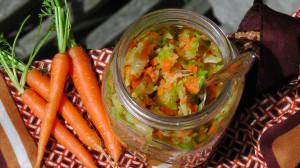
You Will Need
- 1 medium green or red cabbage
- 2 medium carrots
- 1 1/2 tablespoons Himalayan salt
- 2 large jars
What To Do
- Remove the outer leaves of your cabbage. Put aside a couple of large leaves to use at the end.
- Slice or shred the cabbage into small pieces and grate the carrots.
- Place cabbage and carrot in a large bowl with the salt.
- Using your hands start to massage and squeeze the cabbage. Keep massaging and squeezing it. The cabbage and carrot will start to become limp and watery over time. This takes about 5-10 minutes.
- Tightly pack your shredded cabbage and carrot mixture into each jar, and compress down using your hands or a smaller jar to remove any air. Top with a cabbage leaf, tucking it down the sides of the jar. Make sure the veggies are completely covered with brine and that the brine is all the way to the top of the jar, to eliminate any trapped air.
- Put the lids on your jars loosely, as they will expand due to the gases produced in fermentation. Alternatively, you could cover with a cheesecloth and push the veges under the liquid each day to make sure they are submerged.
- Keep the jars at room temperature on your counter for 3-10 days. Sauerkraut or fermented veggies are usually done in 3 – 4 days. In the winter, they may need 7-10 days. The only way to tell when they are done is to have a taste. When you are happy with the taste, pop the jars in the fridge to slow down the fermentation. The sauerkraut will slowly mature further if you don’t eat it all before then!
- Never eat out of the jar, as you will contaminate the batch. Use a clean spoon and serve on another plate. Make sure the remaining sauerkraut is covered with liquid before replacing the lid.

